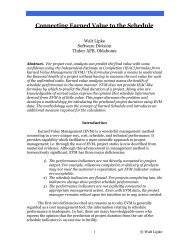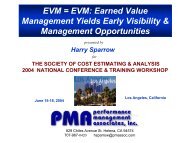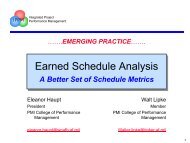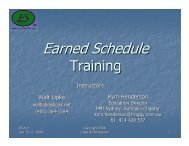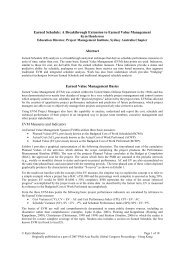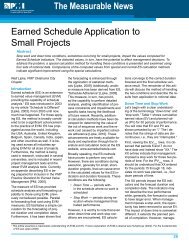Earned Schedule Leads to Improved Forecasting
Earned Schedule Leads to Improved Forecasting
Earned Schedule Leads to Improved Forecasting
Create successful ePaper yourself
Turn your PDF publications into a flip-book with our unique Google optimized e-Paper software.
17 th IPMC<br />
Tyson’s Corner, VA.<br />
Nov 7-9, 2005<br />
<strong>Earned</strong> <strong>Schedule</strong> <strong>Leads</strong><br />
<strong>to</strong> <strong>Improved</strong> <strong>Forecasting</strong><br />
Walt Lipke<br />
waltlipke@cox.net<br />
(405) 364-1594<br />
Copyright © 2005 Lipke
Purpose<br />
To discuss the application of <strong>Earned</strong><br />
<strong>Schedule</strong> <strong>to</strong> schedule and cost prediction<br />
2
Overview<br />
• <strong>Earned</strong> <strong>Schedule</strong> Review<br />
• Prediction Study<br />
• Network <strong>Schedule</strong> Analysis<br />
• <strong>Earned</strong> Value Research<br />
• Concept of Effective <strong>Earned</strong> Value<br />
• <strong>Forecasting</strong> with Effective EV<br />
• Summary<br />
3
<strong>Earned</strong> <strong>Schedule</strong> Concept
So, what’s the problem?<br />
• Traditional schedule EVM metrics are good at beginning<br />
of project<br />
− Show schedule performance trends<br />
• But the metrics don’t reflect real schedule performance at<br />
end<br />
− Eventually, all “budget” will be earned as the work is<br />
completed, no matter how late you finish<br />
• SPI improves and ends up at 1.00 at end<br />
of project<br />
• SV improves and ends up at $0 variance<br />
at end of project<br />
5
So, what’s the problem?<br />
• Traditional schedule metrics lose predictive ability over<br />
the last third of the project<br />
− Impacts schedule predictions, EAC predictions<br />
• Project managers don’t<br />
understand schedule<br />
performance in terms of budget<br />
…Like most of us!<br />
6
<strong>Earned</strong> <strong>Schedule</strong> Concept<br />
BCWP<br />
SPI($) =<br />
BCWS<br />
SV($)<br />
= BCWP<br />
− BCWS<br />
BCWS<br />
ES<br />
SPI(t) =<br />
AT<br />
SV(t) = ES − AT<br />
Projection of BCWP<br />
on<strong>to</strong> BCWS<br />
$<br />
BCWP<br />
ES<br />
ES<br />
AT<br />
= All of May + Portion of June<br />
BCWP($) - BCWS(May)<br />
= 5 +<br />
BCWS(June) - BCWS(May)<br />
= 7<br />
J F M A M J J A S O N<br />
Time<br />
Copyright 2003 Lipke 7
<strong>Earned</strong> <strong>Schedule</strong>:<br />
The Formulae<br />
• ES cum is the:<br />
Number of completed BCWS time increments BCWP<br />
exceeds + the fraction of the incomplete BCWS increment<br />
• ES cum = C + I where:<br />
C = number of time increments for BCWP ≥ BCWS<br />
I = (BCWP – BCWS C ) / (BCWS C+1 – BCWS C )<br />
• ESperiod(n) = EScum(n) – EScum(n-1)<br />
= ∆ES cum<br />
8
• Key Points:<br />
<strong>Earned</strong> <strong>Schedule</strong> Indica<strong>to</strong>rs<br />
– ES Indica<strong>to</strong>rs constructed <strong>to</strong> behave in an<br />
analogous manner <strong>to</strong> the EVM Cost Indica<strong>to</strong>rs,<br />
CV and CPI<br />
– SV(t) and SPI(t) are not constrained by BCWS<br />
calculation reference<br />
– SV(t) and SPI(t) provide duration based<br />
measures of schedule performance<br />
9
Table of Formulas<br />
Metrics<br />
<strong>Earned</strong> <strong>Schedule</strong><br />
ES cum<br />
ES = C + I number of complete<br />
periods (C) plus an incomplete<br />
portion (I)<br />
Actual Time<br />
AT cum<br />
AT = number of periods executed<br />
<strong>Schedule</strong> Variance<br />
SV(t)<br />
SV(t) = ES - AT<br />
Indica<strong>to</strong>rs<br />
<strong>Schedule</strong> Performance<br />
Index<br />
SPI(t)<br />
SPI(t) = ES / AT<br />
To Complete <strong>Schedule</strong><br />
TSPI(t)<br />
TSPI(t) = (PD – ES) / (PD – AT)<br />
Performance Index<br />
TSPI(t) = (PD – ES) / (ED – AT)<br />
Predic<strong>to</strong>rs<br />
Independent Estimate<br />
IEAC(t)<br />
IEAC(t) = PD / SPI(t)<br />
at Completion (time)<br />
IEAC(t) = AT + (PD – ES) / PF<br />
Copyright 2005 Lipke 10
Application Results
ES Applied <strong>to</strong> Real Project Data:<br />
Late Finish Project: SV($) and SV(t)<br />
Commercial IT Infrastructure Expansion Project Phase 1<br />
Cost and <strong>Schedule</strong> Variances<br />
at Project Projection: Week Starting 15th July xx<br />
CV cum SV cum Target SV & CV SV (t) cum<br />
20<br />
2<br />
0<br />
0<br />
Dollars (,000)<br />
-20<br />
-40<br />
-60<br />
-80<br />
-100<br />
S<strong>to</strong>p wk 19<br />
Sched wk 20<br />
Re-start wk 26<br />
-2<br />
-4<br />
-6<br />
-8<br />
-10<br />
W eeks<br />
-120<br />
-12<br />
-140<br />
-14<br />
-160<br />
1 2 3 4 5 6 7 8 9 10 11 12 13 14 15 16 17 18 19 20 21 22 23 24 25 26 27 28 29 30 31 32 33 34<br />
Elapsed Weeks<br />
-16<br />
Rights Reserved 12
Duration Prediction
IEAC(t) Predictions using pre ES Techniques:<br />
Early and Late Finish Project Examples<br />
IEAC(t) Metrics at Project Completion<br />
Early Finish Project<br />
Planned Duration (weeks) 25<br />
Actual Time (weeks) 22<br />
Percentage Complete cum 100%<br />
CPI cum 2.08<br />
SPI(t) cum 1.14<br />
SPI($) cum 1.17<br />
Critical Ratio cum 2.43<br />
IEAC(t) PD/SPI(t) cum 22.0<br />
IEAC(t) PD/SPI($) cum 21.4<br />
IEAC(t) PD/CR cum 10.3<br />
IEAC(t) Metrics at Project Completion<br />
Late Finish Project - pre ES<br />
Planned Duration (weeks) 20<br />
Actual Time (weeks) 34<br />
Percentage Complete cum 100%<br />
CPI cum 0.52<br />
SPI(t) cum 0.59<br />
SPI($) cum 1.00<br />
Critical Ratio cum 0.52<br />
IEAC(t) PD/SPI(t) cum 34.0<br />
IEAC(t) PD/SPI($) cum 20.0<br />
IEAC(t) PD/CR cum 38.7<br />
• In both examples, the pre ES predic<strong>to</strong>rs (in red) fail <strong>to</strong><br />
correctly calculate the Actual Duration at Completion!<br />
• The ES predic<strong>to</strong>r, SPI(t) alone correctly calculates the<br />
Actual Duration at Completion in both cases<br />
Rights Reserved 14
<strong>Schedule</strong> Analysis
<strong>Schedule</strong> Analysis with EVM?<br />
• The general belief is EVM cannot be used <strong>to</strong> predict<br />
schedule duration<br />
• Most practitioners analyze schedule from the bot<strong>to</strong>m up<br />
using the networked schedule ….“It is the only way possible.”<br />
– Analysis of the <strong>Schedule</strong> is overwhelming<br />
– Critical Path is used <strong>to</strong> shorten analysis<br />
(CP is longest path of the schedule)<br />
• Duration prediction using <strong>Earned</strong> <strong>Schedule</strong> provides a<br />
macro-method similar <strong>to</strong> the method for estimating Cost<br />
– a significant advance in practice<br />
• But, there’s more that ES facilitates ….<br />
16
<strong>Earned</strong> <strong>Schedule</strong><br />
Bridges EVM <strong>to</strong> “Real” <strong>Schedule</strong><br />
$$<br />
PV<br />
BAC<br />
EV<br />
SV(t)<br />
Copyright 2004 Lipke<br />
Time<br />
ES<br />
AT<br />
PD<br />
17
How Can This Be Used?<br />
• Tasks behind – possibility of impediments<br />
or constraints can be identified<br />
• Tasks ahead – a likelihood of future rework<br />
can be identified<br />
• The identification is independent from<br />
schedule efficiency<br />
• The identification can be au<strong>to</strong>mated<br />
• PMs can now have a schedule analysis <strong>to</strong>ol<br />
connected <strong>to</strong> the EVM Data!!<br />
18
<strong>Earned</strong> Value Research
<strong>Earned</strong> Value Research<br />
• Most research conducted since 1990<br />
– Result of cancellation of Navy A-12 Avenger<br />
– Primary researcher, Dr. David Christensen,<br />
Southern Utah University<br />
– Cost studies using very large DOD projects<br />
• EVM Literature on Dr. Christensen’s<br />
website http://www.suu.edu/faculty/christensend/ev-bib.html<br />
20
Results from EV Research<br />
• Dr. Christensen’s & associates’ findings<br />
– CPI stabilizes @ 20% complete<br />
– CPI tends <strong>to</strong> worsen as EV ⇒ BAC<br />
– |CPI(final) – CPI(20%)| ≤ 0.10<br />
– IEAC = BAC / CPI ≤ Final Cost<br />
when Percent Complete is 20% ⇔ 100%<br />
21
Research Discussion<br />
• CPI tends <strong>to</strong> worsen as EV ⇒ BAC<br />
• IEAC = BAC / CPI ≤ Final Cost<br />
when Percent Complete is 20% ⇔ 100%<br />
• IEAC condition must be true if CPI tendency is<br />
true<br />
• Rationale supporting CPI tendency<br />
– Rework increasing as EV approaches BAC<br />
– Late occurring impacts from constraints/impediments<br />
– Lack of available EV <strong>to</strong>ward end of project<br />
• My conjecture: SPI(t) & IEAC(t) = PD / SPI(t)<br />
behave similarly <strong>to</strong> CPI & IEAC = BAC / CPI<br />
22
CPI & IEAC Behavior<br />
CPIcum versus<br />
Percent Complete<br />
IEAC Behavior<br />
CPIcum<br />
1.06<br />
1.04<br />
1.02<br />
1.00<br />
0.98<br />
0.96<br />
0.2 0.4 0.6 0.8 1.0<br />
Percent Difference<br />
(IEAC - Final Cost) / Final Cost<br />
0.00<br />
0.2<br />
-0.02<br />
0.4 0.6 0.8 1.0<br />
-0.04<br />
-0.06<br />
-0.08<br />
-0.10<br />
Percent Complete<br />
Percent Complete<br />
23
Concept:<br />
Effective <strong>Earned</strong> Value
<strong>Earned</strong> <strong>Schedule</strong><br />
Bridges EVM <strong>to</strong> “Real” <strong>Schedule</strong><br />
$$<br />
PV<br />
BAC<br />
EV<br />
SV(t)<br />
Copyright 2004 Lipke<br />
Time<br />
ES<br />
AT<br />
PD<br />
25
Effective <strong>Earned</strong> Value<br />
• EV isn’t connected <strong>to</strong> task sequence<br />
– Hypothesis: Completion sequence of tasks<br />
affects performance efficiency<br />
• Incorrect task sequencing occurs when there is …<br />
– Impediment or constraint<br />
– Poor process discipline<br />
• Improper performance sequence may cause …<br />
– Overloading of constraint<br />
– Performance of tasks w/o complete inputs<br />
26
Effective <strong>Earned</strong> Value<br />
• Result from improper performance sequence …<br />
– Constraint limited output<br />
• <strong>Schedule</strong> lengthens<br />
• Cost increases while waiting (when other EV<br />
available is severely limited)<br />
– Rework occurs (~ 50%)<br />
• <strong>Schedule</strong> lengthens<br />
• Cost escalates<br />
• Constraint problem & Rework appear late causing …<br />
– CPI & SPI(t) <strong>to</strong> decrease as EV ⇒ BAC<br />
27
Effective <strong>Earned</strong> Value<br />
• <strong>Schedule</strong> Adherence measure is used <strong>to</strong> enhance<br />
the EVM measures<br />
– Early warning for later cost and schedule problems<br />
– Proposed Measure: In accordance with the project<br />
plan, determine the tasks which should be completed or<br />
started for the duration associated with ES. Compare the<br />
associated PV with the EV of the tasks which directly<br />
correspond. Calculate the ratio:<br />
P = Tasks (perf - corr) / Tasks (plan)<br />
= Σ EV j (corresponding) / Σ PV j (plan)<br />
where Σ EV j ≤ Σ PV j<br />
& Σ PV j = EV<br />
Copyright 2004 Lipke 28
Effective <strong>Earned</strong> Value<br />
• Characteristics of the P measure<br />
– P measure cannot exceed 1.0<br />
0 ≤ P ≤ 1.0<br />
– At project completion P = 1.0<br />
– P is likely unstable until project is 20%<br />
complete {similar <strong>to</strong> the behavior of CPI}<br />
• P used <strong>to</strong> compute effective earned value {EV(e)}<br />
29
Effective <strong>Earned</strong> Value<br />
Effective EV<br />
ΣEV j ⇐ PV @ ES<br />
Total EV<br />
EV(r) is performed at risk of creating rework<br />
Portion colored is usable<br />
Portion colored is unusable<br />
EV(r)<br />
Copyright 2004 Lipke 30
Effective <strong>Earned</strong> Value<br />
• Effective earned value is a function of EV, P, and<br />
Rework<br />
EV(e) = f (EV, P, Rework)<br />
• EV(e) = [ (1 + P ∗ R%) / (1 + R%) ] ∗ EV<br />
where R% (Rework Percent) = fraction of EV(r) unusable<br />
/ fraction of EV(r) usable { EV(r) = ΣPV j - ΣEV j }<br />
• EV(e) = [ (P + 2) / 3 ] ∗ EV<br />
when R% = 50%<br />
Copyright 2004 Lipke 31
Effective <strong>Earned</strong> Value<br />
• Effective ES is computed using EV(e) {i.e., ES(e)}<br />
• Effective EV indica<strong>to</strong>rs are …<br />
– CV(e) = EV(e) – AC<br />
– CPI(e) = EV(e) / AC<br />
– SV(te) = ES(e) – AT<br />
– SPI(te) = ES(e) / AT<br />
• The behavior of P may explain Dr. Christensen’s<br />
findings for CPI & IEAC<br />
Copyright 2004 Lipke 32
Graphs of CPI, CPI(e)<br />
& P - Fac<strong>to</strong>r (notional data)<br />
1.2<br />
1.1<br />
CPI<br />
Index Value<br />
1.0<br />
0.9<br />
0.8<br />
CPI(e)<br />
P – Fac<strong>to</strong>r<br />
0.7<br />
0.2 0.3 0.4 0.5 0.6 0.7 0.8 0.9 1.0<br />
Percent Complete<br />
33
Graphs of CPI & SPI(t)<br />
with the P - Fac<strong>to</strong>r<br />
1.2<br />
Index Value<br />
1.1<br />
1.0<br />
0.9<br />
0.8<br />
CPI<br />
CPI(e)<br />
SPI(t)<br />
SPI(te)<br />
P- Fac<strong>to</strong>r<br />
0.7<br />
0.1 0.2 0.3 0.4 0.5 0.6 0.7 0.8 0.9 1.0<br />
Percent Complete<br />
34
Summary:<br />
Effective <strong>Earned</strong> Value<br />
• Lack of adherence <strong>to</strong> the schedule causes EV <strong>to</strong><br />
misrepresent project progress<br />
• P indica<strong>to</strong>r introduced <strong>to</strong> measure schedule<br />
adherence<br />
• Effective EV calculable from P, R% and EV<br />
reported<br />
• Prediction for both final cost and project<br />
duration hypothesized <strong>to</strong> be improved with<br />
Effective <strong>Earned</strong> Value<br />
35
<strong>Forecasting</strong> with<br />
Effective <strong>Earned</strong> Value
<strong>Forecasting</strong> with<br />
Effective <strong>Earned</strong> Value<br />
<strong>Schedule</strong> Prediction<br />
IEAC(te) = PD / SPI(te)<br />
Cost Prediction<br />
IEAC(e) = BAC / CPI(e)<br />
Copyright 2004 Lipke 37
<strong>Schedule</strong> & Cost<br />
Prediction<br />
(x 1000)<br />
Cost Forecast Comparison<br />
$1,250<br />
IEAC(e)<br />
$1,150<br />
IEAC<br />
$1,050<br />
BAC = $1,000,000<br />
$950<br />
0.2 0.4 0.6 0.8 1.0<br />
Percent Complete<br />
Months<br />
<strong>Schedule</strong> Forecast Comparison<br />
45<br />
IEAC(te)<br />
43<br />
41<br />
IEAC(t)<br />
39<br />
37<br />
PD = 36 months<br />
35<br />
0.2 0.4 0.6 0.8 1.0<br />
Percent Complete<br />
38
Summary
Summary<br />
• ES derived from EVM data … only<br />
• Indica<strong>to</strong>rs do not fail for late finish projects<br />
• <strong>Schedule</strong> prediction is better than any other EVM<br />
method presently used<br />
• Application is scalable up/down, just as is EVM<br />
• Facilitates bridging EVM <strong>to</strong> the schedule<br />
• <strong>Leads</strong> <strong>to</strong> <strong>Schedule</strong> Adherence & Effective <strong>Earned</strong><br />
Value, and …<br />
• <strong>Improved</strong> Cost & <strong>Schedule</strong> <strong>Forecasting</strong><br />
40
References<br />
• “<strong>Schedule</strong> is Different,” The Measurable News,<br />
March & Summer 2003 [Walt Lipke]<br />
• “<strong>Earned</strong> <strong>Schedule</strong>: A Breakthrough Extension <strong>to</strong><br />
<strong>Earned</strong> Value Theory? A Retrospective Analysis of<br />
Real Project Data,” The Measurable News, Summer 2003<br />
[Kym Henderson]<br />
• “Further Developments in <strong>Earned</strong> <strong>Schedule</strong>,”<br />
The Measurable News, Spring 2004 [Kym Henderson]<br />
• “Connecting <strong>Earned</strong> Value <strong>to</strong> the <strong>Schedule</strong>,” The<br />
Measurable News, Winter 2004 [Walt Lipke]<br />
http://sydney.pmichapters-australia.org.au/<br />
Click “Education,” then “Presentations and Papers” for .pdf copies<br />
41
Contact Information<br />
Walt Lipke<br />
Address: 1601 Pembroke Drive<br />
Norman, OK 73072<br />
Phone: (405) 364-1594<br />
Email: waltlipke@cox.net<br />
42



